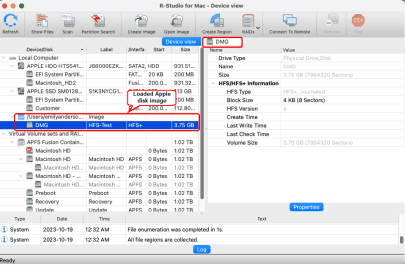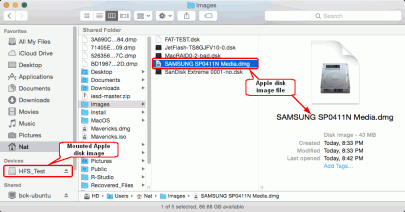-
Data Recovery from Apple Disk Images (.DMG files)
Apple Disk Images are files (usually with the .DMG extension) which the Mac OS X operating system uses to store disk images, with optional data compression and encryption. Such images can be mounted as volumes to access stored data directly from the operating system.
Apple disk images are mostly used for software distribution over the Internet, but Mac OS X users can create images of their own disks. And sometimes data recovery from such images is required. This brief article explains how to use R-Studio for this task.
Note: We assume that the Apple disk images themselves are good and mountable, only data in the imaged disks may be corrupted or lost.
Starting from R-Studio for Mac version 7.3.191246, for Windows version 9.3.191223, and for Linux 5.3.191246, all licenses, the program supports work with Apple Disk Images (.dmg). These files can be loaded directly into R-Studio and opened the same way as other images.

Fig.1. Apple disk image loaded into R-Studio for Mac
By the way, R-Studio can work with other images and virtual disk formats. You may read more about this in our article Data Recovery from Various File Container Formats and Encrypted Disks.
If you have R-Studio version earlier than these, we recommend you to upgrade R-Studio to the latest version to be able to use all its new features.
If you can't upgrade, you may work with Apple disk images in the following ways:
R-Studio for Mac
1. Double-click the Apple disk image file to mount it.

Fig.2. Mounted Apple disk image in Finder
Click image to enlarge
2. Locate the mounted Apple disk image in R-Studio.
.png)
Fig.3. Apple disk image in R-Studio for Mac
Click image to enlarge
You may work with this image as it was a real disk.
R-Studio for Windows and Linux
Although there are several programs that can transfer files from Apple disk images to Windows and Linux systems, they cannot provide access to them at the level necessary to recover data. So we need to use a Mac computer to mount the images and then use network data recovery to allow R-Studio for Windows or Linux work with the mounted images.
1. On the Mac computer, double-click the Apple disk image file to mount it.
2. Run R-Studio Agent for Mac. See R-Studio on-line help: R-Studio Agent for Mac for details.
3. Connect R-Studio to the Mac computer. See R-Studio on-line help: Data Recovery over Network for details.
4. Locate the mounted Apple disk image in R-Studio.
.png)
Fig.4: Apple disk image in R-Studio for Windows
Click image to enlarge
.png)
Fig.5: Apple disk image in R-Studio for Linux
Click image to enlarge
You may work with this image as it was a real disk.
- Data Recovery Guide
- Why R-Studio?
- R-Studio for Forensic and Data Recovery Business
- R-STUDIO Review on TopTenReviews
- File Recovery Specifics for SSD devices
- How to recover data from NVMe devices
- Predicting Success of Common Data Recovery Cases
- Recovery of Overwritten Data
- Emergency File Recovery Using R-Studio Emergency
- RAID Recovery Presentation
- R-Studio: Data recovery from a non-functional computer
- File Recovery from a Computer that Won't Boot
- Clone Disks Before File Recovery
- HD Video Recovery from SD cards
- File Recovery from an Unbootable Mac Computer
- The best way to recover files from a Mac system disk
- Data Recovery from an Encrypted Linux Disk after a System Crash
- Data Recovery from Apple Disk Images (.DMG files)
- File Recovery after Re-installing Windows
- R-Studio: Data Recovery over Network
- How To Use R-Studio Corporate Package
- Data Recovery from a Re-Formatted NTFS Disk
- Data Recovery from an ReFS disk
- Data Recovery from a Re-Formatted exFAT/FAT Disk
- Data Recovery from an Erased HFS Disk
- Data Recovery from an Erased APFS Disk
- Data Recovery from a Re-Formatted Ext2/3/4FS Disk
- Data Recovery from an XFS Disk
- Data Recovery from a Simple NAS
- How to connect virtual RAID and LVM/LDM volumes to the operating system
- Specifics of File Recovery After a Quick Format
- Data Recovery After Partition Manager Crash
- File Recovery vs. File Repair
- Data Recovery from Virtual Machines
- How to Connect Disks to a Computer
- Emergency Data Recovery over Network
- Data Recovery over the Internet
- Creating a Custom Known File Type for R-Studio
- Finding RAID parameters
- Recovering Partitions on a Damaged Disk
- NAT and Firewall Traversal for Remote Data Recovery
- Data Recovery from an External Disk with a Damaged File System
- File Recovery Basics
- Default Parameters of Software Stripe Sets (RAID 0) in Mac OS X
- Data Recovery from Virtual Hard Disk (VHD/VHDX) Files
- Data Recovery from Various File Container Formats and Encrypted Disks
- Automatic RAID Parameter Detection
- IntelligentScan Data Recovery Technology
- Multi-pass imaging in R-Studio
- Runtime Imaging in R-Studio
- Linear Imaging vs Runtime Imaging vs Multi-Pass Imaging
- USB Stabilizer Tech for unstable USB devices
- Joint work of R-Studio and PC-3000 UDMA hardware
- Joint work of R-Studio and HDDSuperClone
- R-Studio T80+ - A Professional Data Recovery and Forensic Solution for Small Business and Individuals Just for 1 USD/day
- Backup Articles
- R-Drive Image Standalone and Corporate license transferring
- Backup with Confidence
- R-Drive Image as a free powerful partition manager
- Computer Recovery and System Restore
- Disk Cloning and Mass System Deployment
- Accessing Individual Files or Folders on a Backed Up Disk Image
- Creating a Data Consistent, Space Efficient Data Backup Plan for a Small Business Server
- How to Move the Already Installed Windows from an Old HDD to a New SSD Device and Create a Hybrid Data Storage System
- How to Move an Installed Windows to a Larger Disk
- How to Move a BitLocker-Encrypted System Disk to a New Storage Device
- How to backup and restore disks on Linux and Mac computers using R-Drive Image
- Undelete Articles
- Get Deleted Files Back
- Free Recovery from SD and Memory cards
- R-Undelete: Video Recovery
- Recovery from an External Device with a Damaged File System
- File recovery from a non-functional computer
- Free File Recovery from an Android Phone Memory Card
- Free Photo and Video File Recovery Tutorial
- Easy file recovery in three steps
Rating: 5.0 / 5
I used some software for data recovery on MAC, but THIS IS only one, that help me!!!
THX :)
bye
Tom from Hungary
Needless to say a RAID0 set created using Apple`s Disk Utility was broken and formatted as a new RAID0. I immediately recognized my mistake and shut down the server.
After some web surfing and saki I found R-Studio.
After the other utilities I normally use failed, R-Studio was able to create an image of the broken (and reformatted) RAID disks.
The entire volume ...
________________________________
5+ I was able to repair my RAID-5 for Mac volume to 20 TB - it`s the best solution. I would recommend.
I would just like to thank you for an excellent product. I was able to recover nearly a terabyte of data after a raid 6 array failed. My customer was ecstatic over the results




